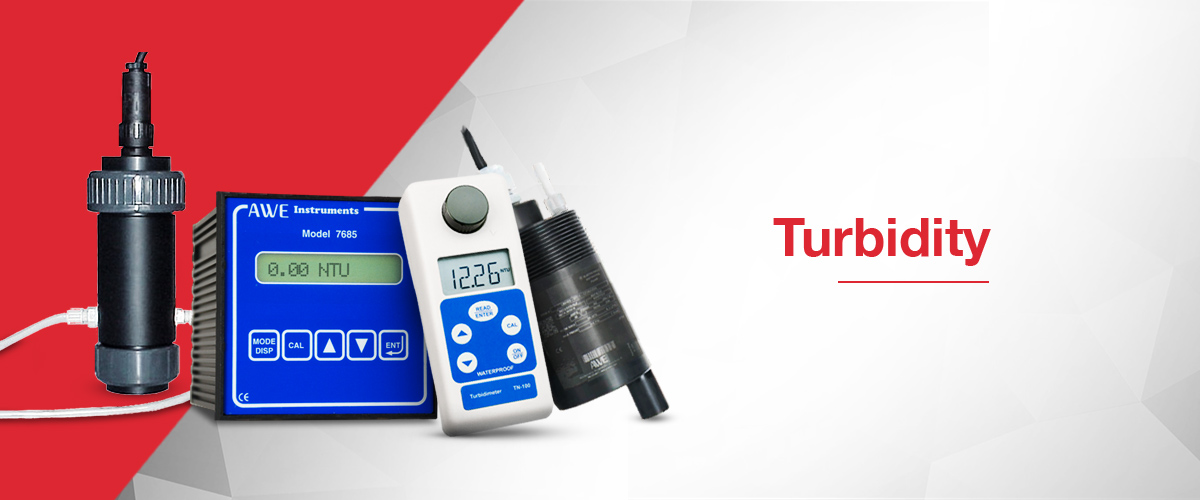Turbidity
Turbidity measurements are used as an indicator of water clarity. Most commonly Turbidity is used in drinking water analysis, in aquaculture applications and as an indicator of water quality from industrial water treatment applications.
Turbidity is defined as "an optical property that causes light to be scattered and absorbed - rather than transmitted in straight lines through a sample". The scattering and absorption of light in a measured solution is caused by undissolved particles. These undissolved particles can be anything that interrupts light passing through - commonly these are suspended solids, algae, or organic matter.
Turbidity is qualitative or inferred measurement as changes can be caused by a wide variety of substances as well as the particle properties. This can include the size, the shape and the refractive index of the individual particles within the measured solution.
Turbidity Measuring Units - NTU or FTU?
Considering the variables that can affect a turbidity measurement - a standard had to be produced that was repeatable and conformed to acceptable standards of purity and stability. Thanks to the work of Kingsbury, Clark, Williams, and Post in 1926 (Kingsbury,F.B., Clark,C.P., Williams,G., and Post,A.L. (1926). J. Lab. clin. Med., 11, 981) a standard measuring unit for Turbidity was devised - this primary standard is prepared using hydrazine sulfate and hexamethylenetetramine to give us Formazin.
This Formazin solution was accepted as the primary Turbidity standard in 1971 and is specified by the United States Environmental Protection Agency.
As the primary standard for the measurement of Turbidity - all instruments are calibrated using Formazin - which gives us the Formazin Turbidity Unit or FTU.
Alternative ways of reporting Turbidity are most commonly using NTU - Nephelometric Turbidity Unit, FNU - Formazine Nephelometric Unit or in FTU - Formazine Turbidity Unit.
An NTU specifies that an instrument has a photoreceptor positioned at 90° from the light source and the wavelength is typically 480 - 600nm (white light spectrum) and is the method that complies with the USEPA Method 180.1.
An FNU also specifies that an instrument has a photoreceptor positioned at 90° from the light source, but the wavelength is typically 780 - 900nm (infrared) and is the method that complies with ISO 7027, the European drinking-water protocol.
Turbidity instruments should be calibrated using the primary standard Formazin - so when immersed in a standard solution of 1 FTU, then 1 FTU = 1 NTU = 1 FNU. When different wavelengths of light are used to measure different samples, the results may differ and should not be directly compared.
Measuring Turbidity
We use both white light and infra-red light sources to offer unparalleled accuracy at low range turbidity measurements. We also offer a higher range turbidity sensor, offering accurate and reliable turbidity measurements.
Our low range turbidity sensors offer accurate readings as low as 0.001 NTU and up to 400.0 NTU - which makes them ideal for drinking water analysis as well as raw water analysis or even final effluent monitoring - all within the same instrument.
For upper ranges - we use a different methodology which gives a maximum turbidity range of 10'000 FTU which is suitable for a whole range of process and aquaculture applications.
Turbidity Instruments & Turbidity Sensor Range
Portable Turbidity Meter
A Turbidity meter is a piece of portable instrumentation for taking into the field for making turbidity measurements.
Our Turbidity meter range is battery operated and includes a full suite of calibration solutions and sample vessels allowing the instrument to make accurate turbidity measurements anywhere required.
Using the ISO 7027 compliant 90° back scattering methodology our protable Turbidity Meters are also approved by the EPA (United States Environmental Protectio Agency) - so you can be confident in your Turbidity measurements.
Turbidity Transmitter
Our Turbidity Transmitters combine an integrated Turbidity Sensor complete with the electronics to provide a 4-20mA current output for integration directly into a PLC, Digital Chart Recorder or Online Data Logger.
Using the nephelometric principle or back scattering principle our range of Turbidity Transmitters are ideally suited for drinking water, post filtration, raw water, effluent monitoring applications as well as a range of process and aqua culture applications.
The turbidity transmitter range have measuring ranges as low as 0.001 NTU and all the way up to 10'000 FTU measurements.
The turbidity transmitters are available as either flow line / pipe mounting turbidity transmitters or as submersible dip mounting turbidity transmitters.
Our submersible turbidity transmitters are also available with an optional auto-clean nozzle for hassle free installation.
Turbidity Controller
Our range of Turbidity Controllers offer accurate, dependable and repeatable Turbidity measurements as well as the control of Turbidity based processes.
The Turbidity Controller range includes independant set-points and relays, as well as alarm relays, and auto-clean relays for controlling either an air-blast or liquid cleaning solution - complete with freeze & hold functionality.
In addition to the control functionality the turbidity controllers also have an isolated 4-20mA output for connecting to compatible equipment.
Simple to operate, with powerful control options, easy to calibrate, and the display showing the current measurement and relay status - our Turbidity Controllers are excellent instruments for both environmental and process applications.
Turbidity Sensor
Our Turbidity Sensors are designed to inegrate with out Turbidity Controller range and offer exellent measurements based on the Nephelometric prinicple.
Using light broadcast ine infrared spectrum with 90° back scattering technology the Turbidity Sensors can read measurements across a range of:-
- 0 - 4.000 NTU
- 0 - 40.00 NTU
- 0 - 400.0 NTU
- 0 - 4000 NTU
Available for either submersion mounting using a riser tube or for inline mounting via a sample line - the Turbidity Sensor range offer accurate measurements and excellent repeatability.






